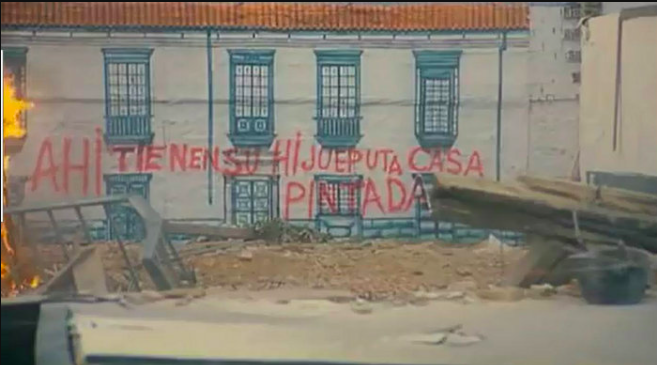Yesterday, I broke a chair. I’m not particularly proud of the fact, but I’m also sorry / not sorry. If by any chance the owners of Sapos pizza bar are reading this, then I will indeed pay for the damage. But I suspect the chair must have been pretty flimsy in the first place. And it was part of a performance that is perhaps symptomatic of my feelings about this place, and even of a couple of other things, too.
I can’t sing. When I was at primary school, I was asked simply to mouth the words of collective songs and hymns, as the noise I was emitting was deemed to be putting everyone else off. But I do like performing. So when, years ago, in Lima, I was taken by some friends to the karaoke bar at the Centro Cultural Peruano Japonés, I couldn’t resist putting myself forward. And the only song they had available (probably by some kind of mistake) that seemed to fit my style, and which didn’t involve any actual singing–rather, shouting–was the Sid Vicious version of “My Way.” Which duly became my karaoke party piece, although only in Peru. Elsewhere, I tend (with only very occasional exceptions) to avoid karaoke. But in Peru, I sing. And I sing Sid Vicious.
So when the students excitedly wanted to go to a makeshift karaoke bar here in Pisac, I duly trundled along, and after an introductory rendition of “Piano Man” (for which I was helpfully drowned out by their own enthusiastic participation) and a rather less successful attempt at “So Long Marianne” (which I thought they would also turn into a sing-along, but I guess these days young Canadians don’t know their Leonard Cohen), I ended the night as Sid. And when it came to the line “I shot it up or kicked it out,” somewhat carried away by the occasion I kicked at the nearest unoffending article of domestic furniture, which turned out not to be quite as robust as I had imagined.
But a bit of punk in Pisac seems appropriate. Because this is a town riddled with New Age tourists, neo-hippies, and of course the punks hated hippies: “Never trust a hippy,” as they used to say. And to be honest, the posters plastered on Pisac doors featuring white-bearded gringos advertising such things as “Sacred Healing Ceremony and Musical Oracle” or “Psychedelic Counseling” and “Authentic Yoga” were getting me down. So the chair paid the price, in what was no doubt a bit of personal catharsis.
To be honest, though, I do have hippy friends. Yes, the old cliché: “Some of my best friends are hippies.” I’m thinking of one in particular, Steve, who I last saw on a very brief trip to London in March, who is very unwell, and who I fear I will not see again. Indeed, I could no doubt go on at length (also in clichéd fashion) as to why these Pisac neo-hippies are so unlike and different from the “real” hippies that I love back in Penge and Beckenham.
But I think the main thing here is that the New Age business is a distraction. As a group, we’ve almost begun to see and think about it more than about the issues of Indigeneity that we are actually here to consider and reflect on. Not that the two are easily entangled: obviously, the New Age Spiritualism feeds on a construction of Indigeneity that is specific to highland Peru and the Sacred Valley (the very notion of a “sacred” valley). It is not for nothing that they are here, as well as other places (Pisac reminds me for instance of Antigua, Guatemala) where Indigenous culture remains strongly embedded. And of course, for the locals, though there may well be grumbling about some of their ways and their impact on the town, they also contribute to the economy, and the guides for instance willingly play up to the image of spirituality and peace, much in fact as way back in the 1600s Garcilaso de la Vega portrayed Inca imperialism as a process of smothering the subjugated in peace, love, and understanding, “so that however brutish and barbarous they had been they were subdued by affection and attached to [the Inca’s] service by a bond so strong that no province ever dreamed of rebelling” (33). Arguably, the neo-hippies are similarly neo-colonists but preaching wellness, breathwork, and organic veggies. Still, I’m not sure I want much to do with it.
If I were to choose (though I’m not sure I can), I’d rather a punk Indigeneity or Indigenism. This might be along the lines of the graphic artist Cherman Quino, whose work I love. In my office I have a poster of his, which features an image of César Vallejo and the text: “Hay Hermanos muchísimo que hacer. . . y no has hecho ni mierda.” But I think there’s something of the punk spirit in the rebellion of the chicheras in Arguedas’s Los ríos profundos, or even in the multitudinous arrival of the colonos in Abancay at the end of the same book, where they are described as “crawl[ing] around like big lice, bigger than merino sheep; they’d eat up the little animals alive, finishing the people off first” (226). Arguedas is always aware of the dark side, of the threat of Indigeneity. What else is “yawar mayu,” the bloody river that he constantly predicts and fears, but the ultimate in punk? Or, further back, if Garcilaso is hippy, isn’t Guaman Poma the first punk (even before Los Saicos and “Demolición”). Doesn’t his handwritten artwork have something of the aesthetic of Jamie Reid? Or his self-staged interview with the King of Spain something of the sheer chutzpah of the Sex Pistols on TV with Bill Grundy?
Perhaps not. Perhaps this is as much of an imposition or fantasy as that of the neo-hippies. But it’s one I prefer.













